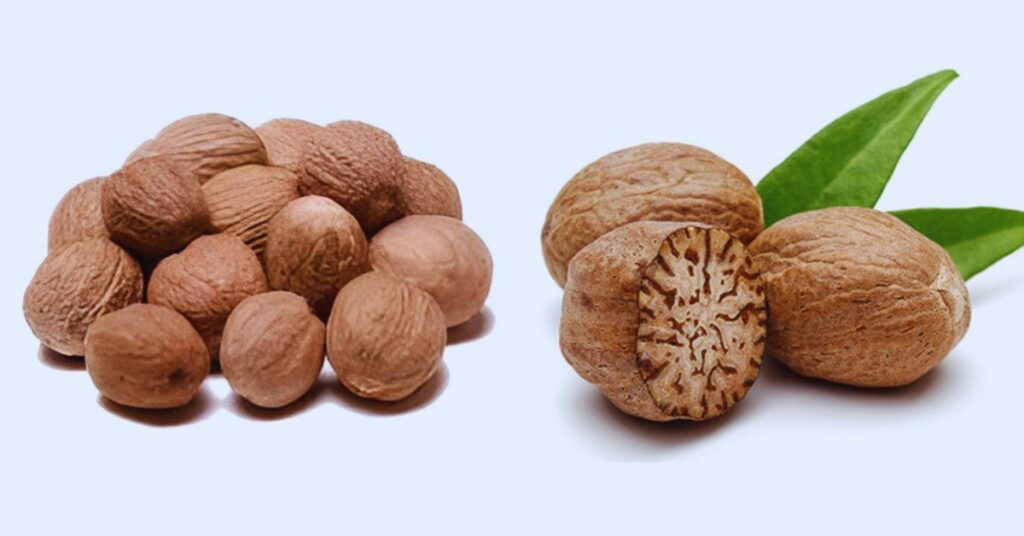Nutmeg, or Мушкатни орашчић in Serbian, is most popular spice because of its warm and sweet flavour. Originating from a seed, it is commonly used in baking, cooking, drinking, and even cosmetics.
Nutmeg is more than simply a spice, though; it has a long history, possible health risks, and a number of fascinating uses. In this essay, we’ll examine its manufacturing method, history, safe usage, and several fascinating facts you probably weren’t aware of.
The Origin of Nutmeg
Where Does Nutmeg Grow?
The Myristica fragrans tree is the source of nutmeg. This tree is indigenous to Indonesia’s Spice Islands, sometimes referred to as the Maluku Islands. In the past, nutmeg was grown only on these islands, making it extremely expensive.
Today, nutmeg is also grown in:
- India (especially Kerala)
- Sri Lanka
- The Caribbean
- South America
The tree is tropical and needs hot, humid weather to grow well.
What Makes It Special?
Both the mace (the red skin surrounding the seed) and nutmeg (the seed) are produced by each tree. It’s very awesome that these two spices are from the same fruit!
Nutmeg Through History
The history of nutmeg is spectacular and lengthy. People fought wars for it in the 1600s because it was so valuable. Both the British and the Dutch desired authority over the Spice Islands. Indeed, the Dutch once gave the British Manhattan Island (present-day New York City) in exchange for a tiny island that grew nutmeg!
In the past, nutmeg was believed to treat a wide range of ailments. People thought it would keep the plague away from them. Because it was regarded as a treasure, it was frequently stored in silver containers or locked away.
Types of Nutmeg
True Nutmeg vs. Mace
Let’s break this down simply:
- Nutmeg is the brown seed inside the fruit. It’s ground into powder or grated fresh.
- Mace is the red, lacy covering on the seed. It turns orange when dried and has a slightly milder taste.
Both are useful in the kitchen and offer a warm, spicy flavor.
California Nutmeg: A Look-Alike
Although it has nothing to do with real nutmeg, there is also something known as California nutmeg. The Torreya californica tree is the source of it. Despite their similar appearance, their seeds are unsafe to consume. It is not utilised as a spice, but as a plant.
How Nutmeg Is Made
From Fruit to Spice
- The nutmeg tree produces a fruit that looks like a small peach.
- When the fruit ripens, it splits open to show the brown seed (nutmeg) and the red aril (mace).
- Farmers remove the seed and the red skin.
Drying and Processing
- The seeds are dried in the sun for 6 to 8 weeks.
- As they dry, the nutmeg shrinks inside its shell.
- Once dry, the shell is cracked open and the seed is taken out.
- The seeds are sold whole or ground into powder.
Why Whole Nutmeg is Better
Whole nutmeg keeps its flavor longer. If you buy it whole and grate it yourself, you’ll get a richer, fresher taste.
Nutmeg in Cooking
Why People Love Nutmeg
Nutmeg has a warm, sweet, and nutty flavor. A little goes a long way. It’s often used in:
- Cakes, pies, and cookies
- Creamy sauces (like white sauce or béchamel)
- Mashed potatoes and pasta
- Curries and spice mixes
- Hot drinks like eggnog, coffee, and tea
Top Dishes That Use Nutmeg
- Pumpkin pie – a fall favorite
- Rice pudding – comforting and creamy
- Lasagna white sauce – adds depth of flavor
- Chai tea – for a spicy twist
- Eggnog – a holiday must
You only need a small pinch — too much can ruin the taste (and your stomach).
Nutmeg in Traditional Medicine
Nutmeg has been used in home remedies for centuries. Some believe it can:
- Help with digestion
- Reduce pain
- Improve sleep
- Freshen breath
In traditional systems like Ayurveda and Chinese medicine, nutmeg is thought to warm the body and calm the mind.
What Science Says
There isn’t much proof that nutmeg helps cure serious illnesses, despite the fact that it contains other chemicals and antioxidants. Enjoying it as a spice rather than a medication is preferable.
Health Benefits of Nutmeg (With a Grain of Salt)
Nutmeg contains:
- Antioxidants – These help fight damage in the body.
- Anti-inflammatory agents – May help reduce swelling.
- Compounds like myristicin and eugenol – Found in essential oils.
These substances may support brain health, mood, and blood sugar levels. But remember: nutmeg isn’t a superfood, and the effects are mild.
Risks of Eating Too Much Nutmeg
Nutmeg is safe in small amounts. But if you eat too much (more than 1-2 teaspoons), it can be dangerous.
Side Effects of Overdosing
- Nausea and vomiting
- Dizziness and confusion
- Hallucinations (seeing or hearing things)
- Fast heartbeat
- Dry mouth
- Seizures (in extreme cases)
This is called nutmeg poisoning. Some people try it for a “high,” but it’s dangerous and not recommended.
Allergic Reactions
Some people may also be allergic. They might get:
- Skin rashes
- Itchy eyes
- Trouble breathing
If that happens, stop using nutmeg and see a doctor.
Nutmeg (Мушкатни орашчић) Essential Oil and Butter
Nutmeg is used not only as a spice but also as an oil and butter.
Nutmeg Essential Oil
This oil is made by steam-distilling crushed seeds. It’s used for:
- Aromatherapy
- Massage
- Pain relief
- Relaxation
Nutmeg Butter
This is a pale yellow fat pressed from the nutmeg seed. It’s used in:
- Soaps
- Lip balms
- Lotions
It smells nice and melts into the skin, making it popular in beauty care.
Nutmeg in Skincare and Beauty
People sometimes use nutmeg in DIY face masks. They say it helps with:
- Pimples
- Scars
- Oily skin
Common Recipes
- Mix nutmeg with honey for acne.
- Combine with milk and oatmeal as a gentle scrub.
Be careful though — nutmeg can irritate sensitive skin. Always do a patch test first.
Nutmeg Around the World
Asia
In countries like India and Indonesia, nutmeg is used in spice blends like:
- Garam masala
- Biryani spice
- Sweet chutneys
Europe
In European cooking, nutmeg is found in:
- Pies and custards
- Potato dishes
- Mulled wine and cider
Middle East and North Africa
Nutmeg is often added to meat dishes for a warm, rich flavor.
How to Store Nutmeg
Best Practices
- Keep nutmeg in an airtight container
- Store in a cool, dry place
- Keep away from light and heat
Whole vs. Ground
- Whole nutmeg lasts up to 4 years
- Ground nutmeg stays fresh for 6 to 12 months
For best taste, buy whole and grate as needed.
Buying Good Nutmeg
What to Look For
- Whole seeds should feel heavy and solid
- Avoid seeds with cracks or mold
- A strong, sweet smell means it’s fresh
Where to Buy
- Local spice stores
- Organic food shops
- Online marketplaces
Always check the expiration date before buying ground nutmeg.
Fun and Surprising Facts About Nutmeg
- Nutmeg was once used as a love potion in the Middle Ages.
- People believed nutmeg could ward off evil spirits.
- The red outer layer (mace) was once more valuable than the seed.
- Nutmeg trees can live for over 70 years.
- There are still spice plantations in Grenada known as the “Isle of Spice.”
Conclusion
Despite its little size, nutmeg (Мушкатни орашчић) has a big personality. It provides scent to your beauty products, adds flavour to your favourite foods, and has centuries of history. It has several advantages, but only when used sparingly and with caution.
Nutmeg is a wonderful addition to any kitchen or home, whether you’re preparing a comforting meal, creating a dessert for the holidays, or attempting a natural beauty recipe.
FAQs
Can nutmeg make you high?
Yes, in large amounts, nutmeg can cause hallucinations, dizziness, and confusion. This is not safe and can lead to serious health problems.
Is nutmeg safe for kids?
Yes, if used in small amounts in food. Never give large doses to children.
Can nutmeg help you sleep?
Some people use it in warm milk at night. It might help you relax, but it’s not a proven sleep aid.
How long does nutmeg stay fresh?
Whole nutmeg lasts up to 4 years. Ground nutmeg should be used within 6–12 months for best flavor.
Can I grow nutmeg at home?
Only if you live in a tropical climate. It’s hard to grow indoors or in cold areas because the tree needs hot, humid weather to thrive.

